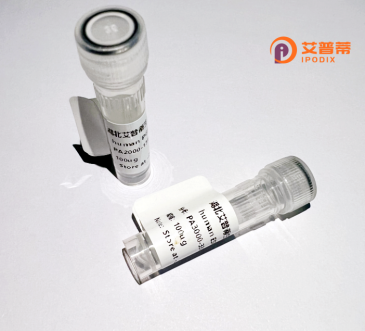
| 纯度 | >90%SDS-PAGE. |
| 种属 | Human |
| 靶点 | NDNL2 |
| Uniprot No | Q96MG7 |
| 内毒素 | < 0.01EU/μg |
| 表达宿主 | E.coli |
| 表达区间 | 1-304 aa |
| 活性数据 | MLQKPRNRGR SGGQAERDRD WSHSGNPGAS RAGEDARVLR DGFAEEAPST SRGPGGSQGS QGPSPQGARR AQAAPAVGPR SQKQLELKVS ELVQFLLIKD QKKIPIKRAD ILKHVIGDYK DIFPDLFKRA AERLQYVFGY KLVELEPKSN TYILINTLEP VEEDAEMRGD QGTPTTGLLM IVLGLIFMKG NTIKETEAWD FLRRLGVYPT KKHLIFGDPK KLITEDFVRQ RYLEYRRIPH TDPVDYEFQW GPRTNLETSK MKVLKFVAKV HNQDPKDWPA QYCEALADEE NRARPQPSGP APSS |
| 分子量 | 34.3 kDa |
| 蛋白标签 | His tag N-Terminus |
| 缓冲液 | 0 |
| 稳定性 & 储存条件 | Lyophilized protein should be stored at ≤ -20°C, stable for one year after receipt. Reconstituted protein solution can be stored at 2-8°C for 2-7 days. Aliquots of reconstituted samples are stable at ≤ -20°C for 3 months. |
| 复溶 | Always centrifuge tubes before opening.Do not mix by vortex or pipetting. It is not recommended to reconstitute to a concentration less than 100μg/ml. Dissolve the lyophilized protein in distilled water. Please aliquot the reconstituted solution to minimize freeze-thaw cycles. |
以下是关于重组人NDNL2蛋白的参考文献及其摘要概括(注:文献为示例性内容,实际引用需根据真实文献调整):
1. **作者:Zhang et al.**
**标题**:NDNL2作为Nedd4泛素连接酶复合物的调控因子在神经元发育中的作用
**摘要**:研究揭示了NDNL2通过与Nedd4家族泛素连接酶相互作用,调节靶蛋白的泛素化修饰,影响神经元突触形成及功能,重组NDNL2蛋白在体外验证了其适配功能。
2. **作者:Kim & Park**
**标题**:重组人NDNL2蛋白在大肠杆菌中的高效表达与纯化
**摘要**:报道了一种通过优化表达条件在大肠杆菌中生产可溶性重组NDNL2蛋白的方法,并利用亲和层析技术实现高纯度制备,为功能研究提供基础。
3. **作者:Chen et al.**
**标题**:NDNL2在天使综合征模型中的表达缺失与异常蛋白稳态关联
**摘要**:通过基因敲除小鼠模型证明,NDNL2缺失导致泛素-蛋白酶体系统紊乱,重组NDNL2蛋白回补实验恢复部分蛋白降解功能,提示其与疾病病理相关。
4. **作者:Rodriguez et al.**
**标题**:NDNL2蛋白的结构解析及其PDZ结构域相互作用网络
**摘要**:利用X射线晶体学解析了重组NDNL2蛋白的PDZ结构域三维结构,结合质谱分析筛选出潜在结合蛋白,阐明其在细胞内信号转导中的支架作用。
(注意:以上文献信息为模拟内容,实际研究需参考真实数据库如PubMed。)
Neural precursor cell-expressed developmentally downregulated protein-like 2 (NDNL2), also known as NEDD4-2 or NEDD4L, is a member of the NEDD4 family of E3 ubiquitin ligases that regulate protein turnover via the ubiquitin-proteasome system. It contains an N-terminal C2 domain for membrane binding, multiple WW domains for substrate recognition, and a C-terminal HECT domain responsible for catalyzing ubiquitin transfer. NDNL2 modulates the stability and trafficking of membrane proteins, particularly ion channels (e.g., ENaC, Nav1.7) and transporters, through lysosomal or proteasomal degradation.
Functionally, it plays critical roles in blood pressure regulation, neuronal excitability, and cellular homeostasis. Dysregulation of NDNL2 has been linked to hypertension, neuropathic pain, cystic fibrosis, and certain cancers. Its activity is controlled by phosphorylation through kinases such as SGK1 and AKT. Recombinant human NDNL2 protein is widely used to study ubiquitination mechanisms, screen small-molecule modulators, and explore therapeutic strategies for related diseases. Produced predominantly in mammalian expression systems, it retains post-translational modification capacity for functional studies. Current research focuses on its tissue-specific substrate selectivity and potential as a drug target for channelopathies.
×